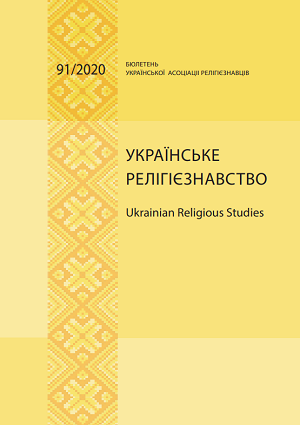Covenants as an echo of the Eucharist. Typos of Lord’s Supper in the Old Testament
DOI:
https://doi.org/10.32420/2020.91.2140Keywords:
Intertextuality, Old and New Testaments, Lord's Supper, covenant relationships, Eucharistic typos, acrificeAbstract
The article uses typological understanding of the Lord's Supper to analyze Old Testament text. Intertextual hermeneutics, which connects the lexical units of various parts of texts for comprehensive understanding allowed to see an echo of the Eucharist in Old Testament. One of the most expressive prototypes or typos of the Lord's Supper in the Old Testament is the idea of the Covenants and changing of the covenants.
The author analyzes the concept of testament and all cases of using this term in Old Testament texts, and concludes that the word “berith” in the biblical text cannot be identified only with the concept of contract, agreement or union. Also, it cannot be identified only with the concept of law, command or statute. The Testament should be taken holistically, combining different meanings of this concept. In this way, the “berith” describes the idea of a specific agreement, which has the character of a bloody decree. Therefore, on the basis of biblical ideas, the concept of a covenant in a broad sense can be presented as a relationship between God and people, which can be described as a God-initiated contract of a personal-corporate nature, which provides for mutual obligations.
This kind of relationship is characterized by a fixed immutability and is accompanied by signs, evidence and a special memory procedure. Therefore, in the Old Testament period, we can confidently talk only about the Covenant with Noah, Abraham and Moses, who were revealed and showed their inner, spiritual essence in the New Testament of Jesus Christ. Only in these cases did the signs of covenant relations in the narrow sense be revealed, namely: God's initiative, personal-corporate relations, the invariability and obligatory commemorativeness are caused. Other ancient covenants do not contain a complete religious component and are not eucharistic prototypes.
An important sign of the typos of the Lord's Supper in the Old Testament is the blood of the covenant. All covenants were accompanied by the shedding of sacrificial blood, which indicated the sacrifice of Christ and its echo in the Eucharistic cup.
This emphasizes the difference between “berith” as a covenant and “berith” as a commandment or statute. Bloodless covenant are not testaments in the full biblical sense of the word. The idea of a testament as a bloodline expresses the highest seriousness of mutual testamentary obligations. That is, a Testament is an inviolable contract, the non-fulfillment of which threatens death.
An additional feature of the testament, as shown in the article, was the theophanic Presence. It manifested itself not only at the time of the covenant, but also in an invisible way throughout its validity. The establishment of a covenant relationship has always been associated with theophany and could not have been otherwise, because the covenant is always personal, so God considered it necessary to show a personal presence at this crucial time.
The author proves that in all pre-Christian covenants there is a single prototype line that was revealed in Jesus Christ. By the faith and merit of the ancestor, his descendants enter into the covenant and enjoy the benefits and blessings of their predecessor, as well as inherit all his obligations to God. The people of the New Testament enjoy all the benefits and advantages not because of their own merits, but only because of the merits of Jesus.
The sign of entering into the Covenant of Jesus is water baptism (Col. 2: 11-13), which, as an external action, plays the role of a spiritual sign that indicates spiritual circumcision as a clipping of all sins.
Thus, the intertextual analysis of the New Testament and Old Testament texts revealed the typos of Lord's Supper and shows the Christ as a single one, who determines the conditions of the covenants and makes it valid.
References
Bakhtin, M.M. (1979). Aesthetics of verbal creativity. M.: Ripol Classic [In Russian].
Kristeva, Y. (2000). French Semiotics: From Structuralism to Poststructuralism. M.: Progress [In Russian].
Lotman, Y. (2010). Semiosphere. M .: Art [In Russian].
Posnov, M. (2014). The idea of God's covenant with the Israelite people in the Old Testament. M .: Ripol Classic [In Russian].
Robertson, O.P. (2008). Christ of God's covenants. Odessa: Tulip [In Russian].
Sprol, R. Ch. (1998). Basic truths of the Christian faith. Odessa: Assistance [In Russian].
Fateeva, N.A. (2007). Intertext in the World of Texts: The Counterpoint of Intertextuality. M .: Kom book [In Russian].
Filatova, O. M. (2006). Intertextuality as a global text category. Bulletin of the Udmurt University. Series "History and Philology", 5-2. [In Russian].
Yuldasheva, L. (2016). Title and intertextual links to the creation. Collection of Science Practitioners Kam'yanets-Podilsky Sovereign Pedagogical Institute. Series of philological, 173-17 [In Russian].
Broadway, M., Freeman, C., Harvey, B., McClendon Jr, J., Newman, E., & Thompson, P. (2019). Rethinking Baptist Identity. Manifesto to the Baptist Congregations of North America. Bogomyslie, 24, 44-57 [In Russian].
Agus, J. B. (1981). The covenant concept—Particularistic, pluralistic, or futuristic. Journal of Ecumenical Studies, 18(2), 217–230.
Clark, R. S., & VanDrunen, D. (2007). The Covenant before the Covenants. Covenant, Justification, and Pastoral Ministry: Essays by the Faculty of Westminster Seminary California, 167–196.
Goppelt, L. (1982). Typos: The typological interpretation of the Old Testament in the New. Wm. B. Eerdmans Publishing.
Helm, P. (2010, August 28). The Covenant of Redemption and Tritheism. Helm’s Deep. Рhilosophical Theology. Отримано з https://paulhelmsdeep.blogspot.com/2010/08/covenant-of-redemption-and-tritheism.html
Lumpkin, W. L. (1959). Baptist confessions of faith. Judson Pr.
Packer, J. I. (1990). An Introduction to Covenant Theology. Fig Classic Series.
Thompson, N. H. (1982). The covenant concept in Judaism and Christianity. Anglican Theological Review, 64(4), 502–524.
Downloads
Published
Issue
Section
License
Copyright (c) 2020 Сергій Вікторович Санніков

This work is licensed under a Creative Commons Attribution-NonCommercial-ShareAlike 4.0 International License.


